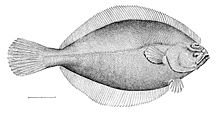American plaice
| American plaice | |
|---|---|

| |
| American plaice, Hippoglossoides platessoides | |
| Scientific classification | |
| Kingdom: | |
| Phylum: | |
| Class: | |
| Order: | |
| Family: | |
| Genus: | |
| Species: | H. platessoides
|
| Binomial name | |
| Hippoglossoides platessoides (O. Fabricius, 1780)
| |
The American plaice or sole, Hippoglossoides platessoides, is a flatfish that belongs, along with other right-eyed flounders, to the Pleuronectidae family. American plaice are an Atlantic species.[1] Their range is from southern Labrador to Rhode Island. They spawn in the Gulf of Maine, with peak activity in April and May. They grow to a maximum length of 70 centimetres (28 in).[2] The species is considered by the Northwest Atlantic Fisheries Organization to be overfished, with no signs of recovery.[3] On the other hand, the Canadian government believes the species is abundant, and counts it as the second most caught flatfish, totalling 50% of the flatfish caught by Canadian fishermen.[4] A 1997 study reports that plaice are endangered in Canada due to overfishing.[5]

American plaice may be an intermediate host for the nematode parasite Otostrongylus circumlitis, which is a lungworm of seals, primarily affecting animals less than 1 yr of age.
References
- ^ "Plaice." Grolier Encyclopedia of Knowledge, volume 15, copyright 1991. Grolier Inc., ISBN 0-7172-5300-7
- ^ [1] Dery, L.M. "American plaice, Hippoglossoides platessoides." Fishery Biology Program, Woods Hole Massachusetts Laboratory of the National Marine Fisheries Service (NMFS), Northeast Fisheries Science Center (NEFSC).retrieved January 18, 2007
- ^ [2] Fishery Recent Assessment (2005 and 2006). Northwest Atlantic Fisheries Organization. retrieved January 18, 2007
- ^ [3] "American plaice." Underwater World. Fisheries and Oceans Canada. retrieved January 18, 2007
- ^ Bergeron et al. 1997. Canadian Journal of Zoology 75: 1364–1371.
